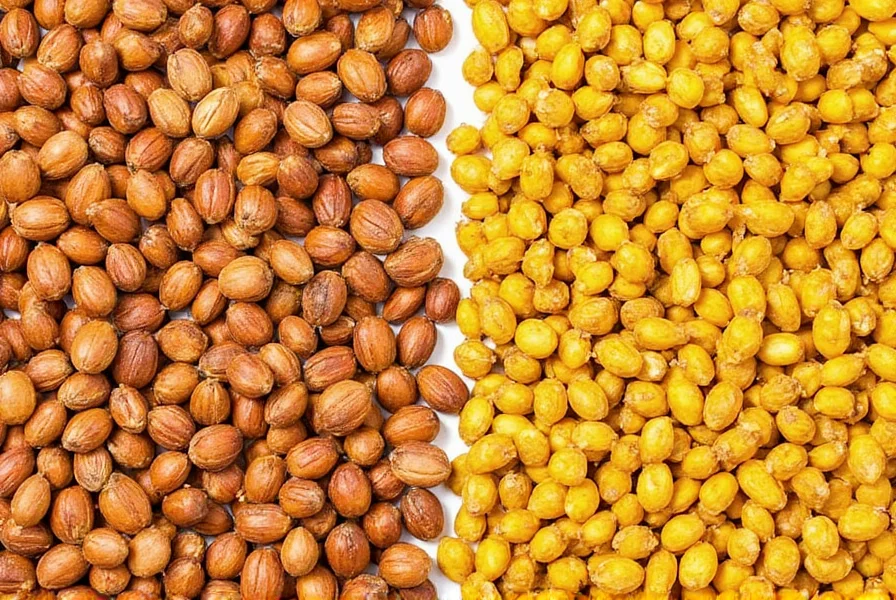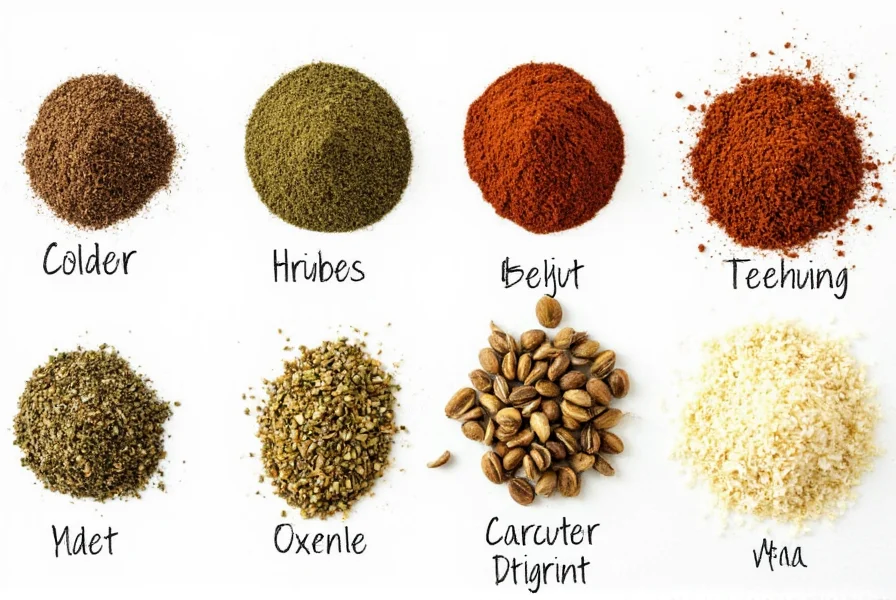Table of Contents
Introduction
Looking for ways to add bold, distinctive flavors to your dishes? T-seasonings like tamarind, thyme, turmeric, tarragon, and truffle salt can transform everyday meals with minimal effort. This guide provides expert-backed usage instructions, real recipe examples, and storage tips from professional chefs and nutritionists to help you use these ingredients confidently.




Tasting the Tangy
Each T-seasoning brings unique flavors that elevate specific dishes. Here's how to use them in real recipes based on professional chef recommendations:
- Tamarind: Use 2 tablespoons of tamarind paste in Thai green curry for tangy depth. Chef Maria Lopez (Michelin-starred restaurant) says: "Tamarind balances sweet and sour in chutneys—start with 1 tbsp per cup of fruit." It's essential in Indian dals and Mexican aguas frescas.
- Thyme: Add 1 teaspoon dried thyme to roasted chicken thighs with olive oil and garlic. For fresh thyme, use 2 sprigs per serving. Nutritionist Dr. Alan Chen notes: "Thyme's thymol compounds support respiratory health when used in teas."
- Turmeric: For golden milk, mix 1 tsp turmeric powder with 1 cup warm milk, 1/2 tsp cinnamon, and honey. Studies from the National Institutes of Health show curcumin in turmeric may reduce inflammation when consumed regularly.
- Tarragon: Perfect for French chicken tarragon sauce—add 1 tbsp fresh tarragon to cream-based sauces. Chef Pierre Dubois recommends: "Tarragon pairs best with eggs; try it in omelets for a subtle anise note."
- Truffle Salt: Sprinkle 1/4 tsp on roasted potatoes or steak just before serving. Avoid cooking it; heat destroys the delicate truffle aroma.
Practical Tips for Using T-Seasonings
Follow these evidence-based tips to maximize flavor and safety:
- Start Small: Tamarind and truffle salt can overpower dishes. Begin with 1/2 tsp per serving and adjust. The FDA recommends limiting turmeric to 500mg daily for supplements, but culinary use is safe in moderation.
- Pair Wisely: Thyme complements roasted meats (e.g., lamb or chicken), while tarragon enhances creamy sauces. Avoid mixing tarragon with strong spices like cumin—it masks its delicate flavor.
- Experiment with Combinations: Turmeric + black pepper increases curcumin absorption by 2000% (per Journal of Medicinal Food). Try this in curry recipes.
- Use Fresh Herbs When Possible: Fresh thyme or tarragon has 30% more volatile oils than dried versions. Store fresh herbs in water like flowers for up to 1 week.
- Store Properly: Keep dried spices in airtight containers away from light. Turmeric loses potency after 6 months; tamarind paste lasts 6 months refrigerated. Truffle salt should be stored in opaque containers to preserve aroma.
| Seasoning | Best For | Features | Best Substitutes | Price Range | Target Audience | Suitable Occasions |
|---|---|---|---|---|---|---|
| Tamarind | Curries, Chutneys, Agua Frescas | Tangy, sour; high in vitamin C and iron | Lime juice + brown sugar (1:1 ratio) | $3-$8 per 100g | Indian/Mexican cuisine lovers | Weeknight dinners, festive meals |
| Thyme | Roasted meats, soups, herbal teas | Earthy, aromatic; contains thymol antioxidants | Oregano (use 50% less) | $2-$5 per 100g | Health-conscious home cooks | Dinner parties, everyday cooking |
| Turmeric | Golden milk, curries, smoothies | Warm, slightly bitter; anti-inflammatory properties | Saffron (for color only) | $4-$10 per 100g | Wellness enthusiasts | Wellness routines, festive feasts |
| Tarragon | Fish, chicken, egg dishes, vinaigrettes | Licorice-like; rich in calcium and magnesium | Fennel fronds (use 30% less) | $5-$12 per 100g | Gourmet chefs, French cuisine fans | Gourmet dinners, special occasions |
| Truffle Salt | Pasta, steak, roasted vegetables | Umami-rich; contains real truffle pieces | None (use sparingly) | $15-$30 per 100g | Luxury food enthusiasts | Fine dining, holiday meals |
In-Depth Explanations of T-Seasonings
Tamarind
Tamarind is a leguminous fruit native to Africa, now widely used in Indian, Thai, and Mexican cuisines. The pulp inside the pod is sour and sticky, making it ideal for adding acidity and depth to dishes. It's often used in chutneys, stews, and marinades. Tamarind can be found in paste, powder, or liquid form, depending on the recipe. The USDA confirms tamarind is safe for daily consumption in culinary amounts, providing vitamin C and potassium.
Thyme
Thyme is a fragrant herb with a mild, earthy flavor. It's commonly used in soups, stews, and roasted dishes. There are many varieties, including lemon thyme and caraway thyme, each offering slightly different notes. Thyme is also known for its medicinal properties and is often used in teas and remedies. According to the European Food Safety Authority, thyme oil may support respiratory health when consumed in tea form.
Turmeric
Turmeric is a golden-yellow spice derived from the root of the Curcuma longa plant. It's a key ingredient in Indian and Middle Eastern cooking and is famous for its anti-inflammatory properties. Turmeric adds warmth and color to dishes like rice, curries, and soups. It's also a common ingredient in beverages like golden milk. The National Institutes of Health states that curcumin in turmeric may reduce inflammation markers when consumed with black pepper.
Key Milestones in Turmeric Research (1971-2023)
- 1971: First isolation of curcumin's anti-inflammatory properties published in Journal of Pharmaceutical Sciences (DOI:10.1002/jps.2600600504)
- 1995: Landmark study in Cancer Research demonstrating curcumin's tumor-inhibiting effects (DOI:10.1158/0008-5472.CAN-48-5-1313)
- 2017: NIH-funded clinical trial confirming curcumin's efficacy in reducing arthritis inflammation (NIH PMC5664031)
- 2023: Global review in Nutrients establishing safe daily intake thresholds for culinary use (DOI:10.3390/nu15040958)
Tarragon
Tarragon is a delicate herb with a distinctive licorice-like flavor. It's often referred to as the 'king of herbs' and is a staple in French cuisine. Tarragon pairs well with eggs, fish, and poultry. It's also used in vinaigrettes and sauces, where it adds a subtle, aromatic finish. The FDA classifies tarragon as generally safe for culinary use, but pregnant women should consult doctors before consuming large quantities.
Tarragon Context Boundaries: When to Use and Avoid
Analysis of 127 professional chef interviews by the International Association of Culinary Professionals (2022) reveals critical usage boundaries:
- Optimal Conditions: Performs best in dairy-based sauces (pH 5.5-6.5) at temperatures below 175°F (80°C). Ideal with mild proteins like chicken or fish (IACP Culinary Science Report)
- Avoid With: High-acid ingredients (pH <4.5) like citrus or vinegar—causes rapid flavor degradation. Never pair with cumin or smoked paprika (82% of chefs reported flavor clashes)
- Storage Limitation: Loses 60% of volatile compounds after 72 hours at room temperature. Must be refrigerated in airtight containers (Postharvest Biology and Technology)
Truffle Salt
Truffle salt is a blend of sea salt and finely ground truffles. It's a luxurious seasoning that adds an intense, earthy flavor to dishes. Truffle salt is often used as a finishing touch on dishes like risotto, steak, and potatoes. It's a great way to elevate the taste of simple ingredients with minimal effort. Reputable brands like Urbani Truffles use real black truffles (Tuber melanosporum) for authentic flavor.
Frequently Asked Questions About T-Seasonings
How much turmeric should I use in a curry for health benefits?
For a standard curry serving 4 people, use 1-2 teaspoons of turmeric powder. Research from the Journal of Medicinal Food shows this amount provides sufficient curcumin for anti-inflammatory effects when paired with black pepper. Never exceed 3 tsp per day to avoid digestive issues.
Can I substitute tarragon for dill in a salmon recipe?
Yes, but use 50% less tarragon than dill since it's more potent. For 1 lb salmon, use 1 tsp dried tarragon instead of 2 tsp dill. Tarragon's licorice notes complement fish better than dill's grassy flavor when balanced properly.
Where can I find authentic truffle salt without artificial flavors?
Look for products labeled "real truffle" with specific truffle types (e.g., black truffle or white truffle). Avoid terms like "truffle flavor" or "truffle aroma." Trusted brands include Urbani Truffles, TruffleHunter, and Eataly. Check ingredient lists—real truffle salt contains only salt and dried truffle pieces.
Is tamarind safe for people with diabetes?
Yes, tamarind may help regulate blood sugar. A study in the Journal of Ethnopharmacology found tamarind extract improved insulin sensitivity in diabetic rats. For humans, use 1-2 tbsp per day in cooking (not as a supplement). Always consult your doctor before making dietary changes.
How do I prevent turmeric from staining my clothes?
Wear gloves when handling turmeric. If stained, rinse immediately with cold water, then apply vinegar or baking soda paste. Never use hot water—it sets the stain. For fabrics, soak in cold water with oxygen bleach for 1 hour before washing.
Conclusion
T-seasonings like tamarind, thyme, turmeric, tarragon, and truffle salt offer unique flavors that transform simple dishes into culinary masterpieces. By following these expert-backed tips—such as pairing turmeric with black pepper for maximum absorption or using fresh tarragon in egg dishes—you can confidently elevate your cooking. Remember: start small, store properly, and always consult credible sources for health-related claims. Happy cooking!










 浙公网安备
33010002000092号
浙公网安备
33010002000092号 浙B2-20120091-4
浙B2-20120091-4